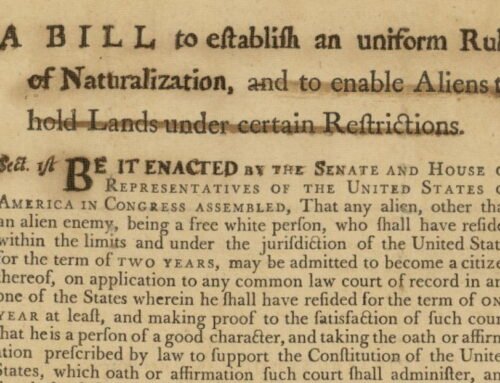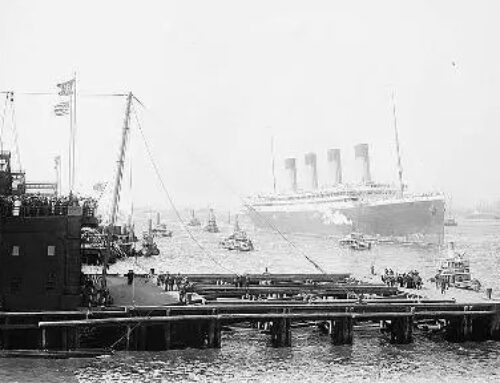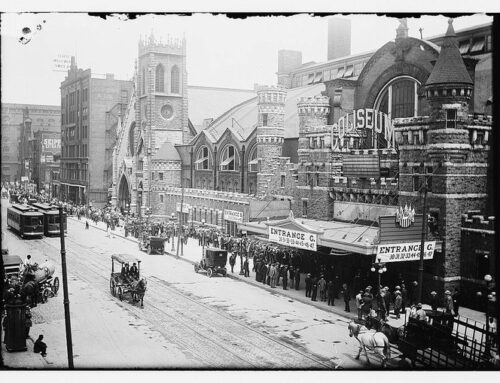Inspectors did not change names at Ellis Island.
There. I said it. So have lots of genealogists.
But somehow the myth persists decades later that inspectors changed names at Ellis Island. Let’s take a brief look at the process.
Today is the anniversary of the busiest day in Ellis Island’s history. One hundred and seven years ago, 11,747 individuals arrived to begin new lives in America. An average day saw 5,000 immigrants processed through Ellis Island.
Mistakes happened and the process was flawed, but immigration officials were most probably not the source of name changes. They were working from passenger lists from the steamship companies. The medical and legal inspections at Ellis Island were necessarily brief. Quite simply, the inspectors didn’t have time to make changes.
Is Hollywood to blame for this misperception?
I don’t have scientific proof, but I think this misperception is widespread because of The Godfather Part II. It has been 40 years since this movie was released. In that time, the idea has spread that Ellis Island inspectors would change an ancestor’s surname. Here is the passage in the script for The Godfather Part II:
THE NEW YORK HARBOR - DAY SILENCE. We glide past the Statue of Liberty. VIEW on the IMMIGRANTS standing on shipboard silently; looking. Vito is standing with them, his eyes wide. CAMERA MOVES IN on the statue, then MOVING PAST, on to the beautiful buildings of Ellis Island. EXT. ELLIS ISLAND - DAY A tugboat pulls a barge brimming with immigrants into the Ellis Island harbor. Uniformed officials of the Immigration Service load them up toward the main building. INT. ELLIS PROCESSING HALL - DAY The hundreds of immigrant families sit on rows of benches in the great hall. Various painted lines lead to the steps and processing rooms above. There is the babble of many interviews going on simultaneously, uncertainly, in different languages. Vito is bundled in an old coat, with a large tag pinned on it: "Vitone Andolini -- Corleone, Sicilia." He stands, moves up in the line, when several other immigrant boys, older than he, rush up an push him back in the line. Weak from the trip, he falls to the floor. The boys laugh, derisive in a language he cannot understand. He struggles to his feet, lifting his makeshift bags; staring at them in an icy hatred. INT. PROCESSING ROOM - DAY Three or four interviews are crowded into the small room; they are conducted in English. From the expression on Vito's face, and from the fragmented of the English, we realize that he doesn't understand a word of it. OFFICIAL (English) What is your name? The man waits, impatiently. OFFICIAL Your name? Vito doesn't answer. The Official pulls the tag pinned onto his coat and copies to down on his form, using a typewriter. OFFICIAL (speaking as he types) Vito...Corleone. Step up, over there. He hands the form to another official. CLOSE VIEW on the form. The name has been entered as Vito Corleone.
The movie continues to the medical exam at Ellis Island:
INT. MEDICAL EXAM - DAY Vito is stripped to the waist, as other immigrants wait. The DOCTOR is just finishing his examination. He shakes his head, and then writes on the medical form. DOCTOR Can you understand me? Vito stares blankly. DOCTOR You understand? Smallpox. Smallpox. He doesn't understand. The doctor turns to the Immigration Official. DOCTOR Quarantine...six months. UNDERGROUND PASSAGEWAY - MOVING VIEW - DAY Officials move a group of immigrant men, including Vito, to the quarantine section of the Island. INT. QUARANTINE HALLWAY - DAY The official stops at each doorway, and reads off a name. OFFICIAL Salvatore Ormenta. The man moves into the room, and the group proceeds. OFFICIAL Vito Corleone. No one responds. The guard moves to the boy, reads his new name tag. And then, not unkindly: GUARD That's you. He opens the door, and Vito enters the room.
New York Public Library Resource on Ellis Island
The New York Public Library weighs in on their websiste, providing additional reasons why inspectors did not change names at Ellis Island:
Inspectors did not create records of immigration; rather they checked the names of the people moving through Ellis Island against those recorded in the ship’s passenger list, or manifest. The ship’s manifest was created by employees of the steamship companies that brought the immigrants to the United States, before the voyage took place, when the passenger bought their ticket. The manifest was presented to the officials at Ellis Island when the ship arrived. If anything, Ellis Island officials were known to correct mistakes in passenger lists. The Encyclopedia of Ellis Island states that employees of the steamship companies,
…mostly ticket agents and pursers required no special identification from passengers and simply accepted the names the immigrants gave them. Immigrant inspectors [at Ellis Island] accepted these names as recorded in the ship’s manifests and never altered them unless persuaded that a mistake had been made in the spelling or rendering of the name. Nonetheless the original name was never entirely scratched out and remained legible. (p.176)
Although it is always possible that the names of passengers were spelt wrong, perhaps by the clerk when the ticket was bought, or during transliteration, when names were translated from one alphabet to another, it is more likely that immigrants were their own agents of change. Cannato, for instance, suggests that people often changed their name in advance of migration. More commonly, immigrants would change their names themselves when they had arrived in the United States, and for a number of reasons.
So it’s clear that inspectors did not change names at Ellis Island. At the next family dinner. Take on that great-uncle (or any other relative) who thinks so, citing actual resources.
 Stymied in your immigrant research? Or perhaps you want to know more about your immigrant ancestors and their experiences? Try Sassy Jane’s Guide to Discovering Immigrant Ancestors genealogy guide. It covers immigrants departing from Europe, the immigrant experience in steerage, arrival at Castle Garden or Ellis Island, and the records that are available to help you find your immigrant ancestors. Resources for ports other than New York are included. So even if your ancestors came through other U.S. ports, this guide can help.
Stymied in your immigrant research? Or perhaps you want to know more about your immigrant ancestors and their experiences? Try Sassy Jane’s Guide to Discovering Immigrant Ancestors genealogy guide. It covers immigrants departing from Europe, the immigrant experience in steerage, arrival at Castle Garden or Ellis Island, and the records that are available to help you find your immigrant ancestors. Resources for ports other than New York are included. So even if your ancestors came through other U.S. ports, this guide can help.





This was really interesting